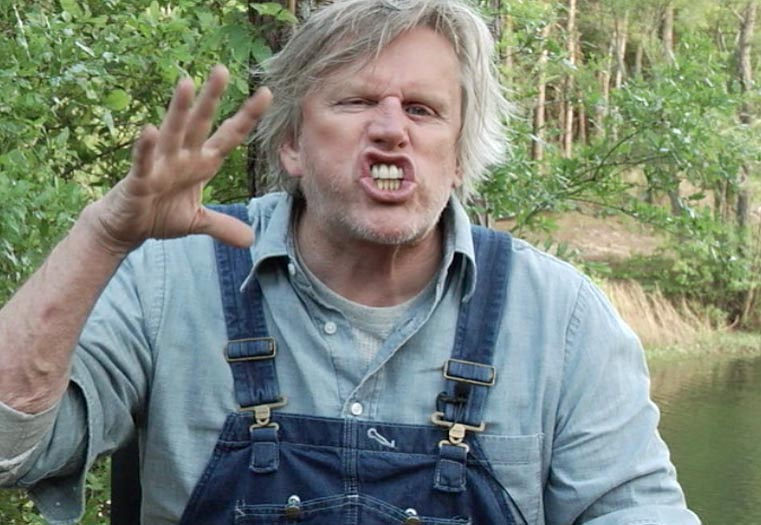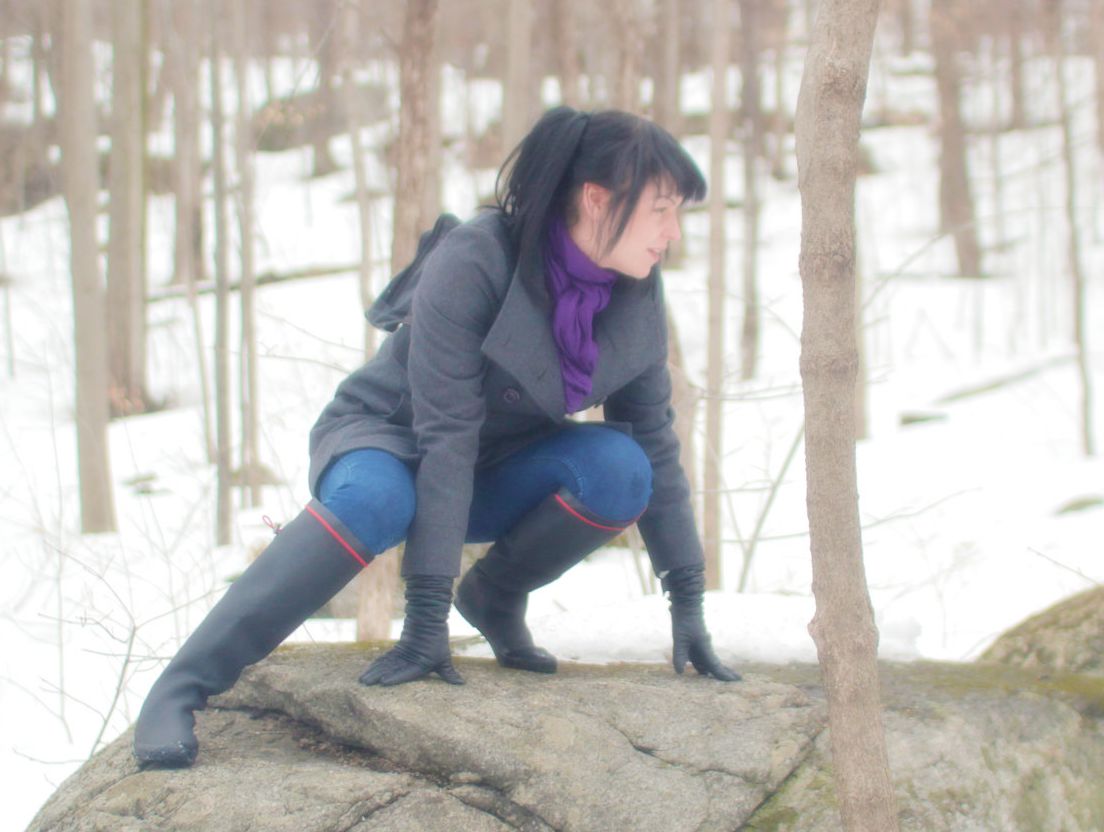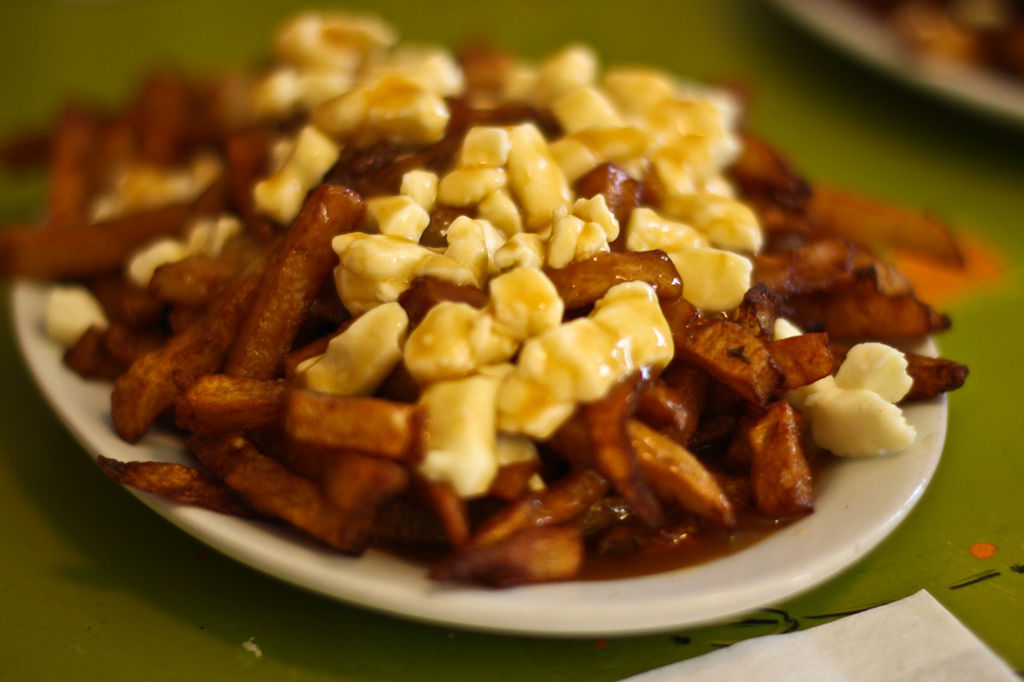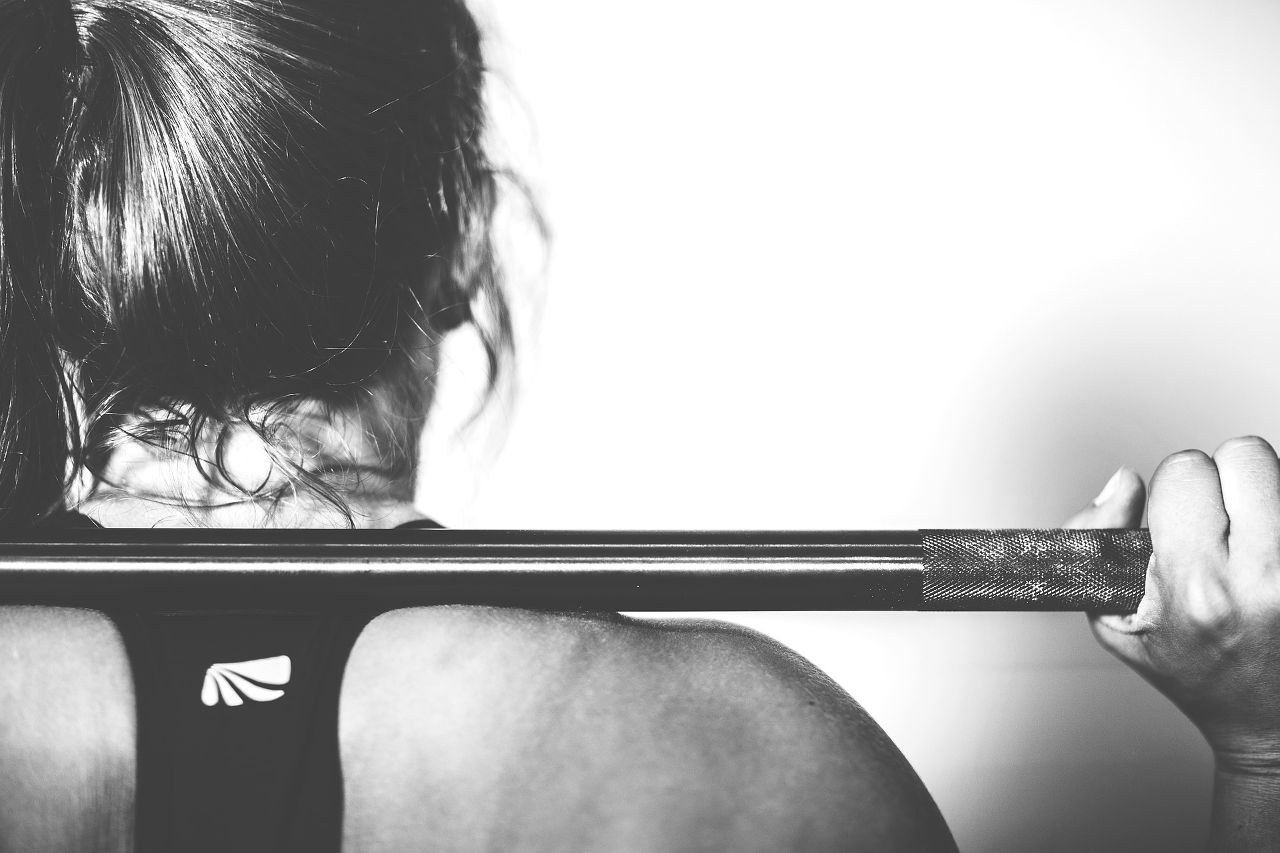How I Became Fit, Killed My Panic Attacks, and Eat What I Want
by Evelyn Reid
Originally published on About.com September 10, 2009
”
“The best decision I ever made in my life was getting fit. And committing to it.”
Getting fit can be a rough process when you’re anything but. In my case, I was more than 40 pounds overweight with a face full of pimples, experiencing daily panic attacks, broke, and already in debt at age 19 living alone in a cramped studio apartment in a housing project with violent neighbors*.
I was terrified and miserable. Something had to give. I needed a change. And I needed it yesterday.
Enter my future fitness trainer.
We met in my first stats class on my first day of my first year in psychology at Concordia University. Sitting to my left, she struck up a conversation with me based on her appreciation of my animé girl sketches (when I’m bored, overwhelmed, procrastinating, or in need of focused attention during a speech or phone call, I draw doe-eyed gangly-limbed ladies with supermodel cheekbones).
I continued our discussion after class based on my admiration of her soon-to-be-revealed favorite pastime: fitness training. By the second class, I mustered up the courage to ask Nina, after a couple of sleepless nights, for help in changing my life.

Photo courtesy of Pixabay
Within a week, Nina showed me the basic ropes of weight training and cardio. By Week 2, she was weaning me off her. By Week 3, I was on my own.
I think many of you who’ve taken the same leap understand the emotional terror of entering gym territory as a fitness newbie. I was mortified—horrified—walking into Concordia University’s Loyola gym, an almost exclusively all-male Concordia Stingers football player weight room of linebackers and halfbacks and special team types heaving away with intimidating side glances as I timidly used one of two rickety Stairmasters, a stationary bike held together with duct tape, and some weight machines and free weights.
But it was the cheapest—tiniest—workout facility out there. It was all I could afford. Yet within a month, barely a week after Nina left me to navigate the scene sans her, I was primed to drop the gym altogether. I mean, what is a dough girl doing in a gym of male athletes, my inner voice berated. I felt so embarrassed and out of place even though I had every right to be there, with or without a full figure.

Photo by Santeri Viinamäki (CC BY-SA 4.0)
Luckily, a friend mentioned interest in joining me so I kept it up. We coordinated our visits for roughly six months, countering the stinging wtf-are-you-girls-doing-on-our-turf vibe with sheer stubbornness, taking solace in dubbing one frequently topless quarterback Gary Busey Number 1. A weight room attendant with a minor underbite became Gary Busey Number 2.

<– Gary Busey
Why the fixation? Some people cope by imagining a crowd in their underwear. I prefer projecting the toothy Texan’s face onto blonds who prance around like cowboys. Lightens the mood.
Apart from having my friend around as a source of support those first six months, my motivation to keep going was also fueled by the single solitary welcoming face on the Stingers team, a man I found out was Sylvain Girard after recognizing him in the newspaper not long after he became a CFL receiver for the Montreal Alouettes, a gentle-mannered type who always wiped his sweat off the equipment.
And smile. He always smiled. And he didn’t look at me like I was appropriating the men’s washroom—seriously guys, what the eff was that about? Girard made me feel like I belonged, no matter how much I stuck out.
Above: Sylvain Girard scoring a touchdown.
Truth be told, it took one year of psychological agony to get hooked on exercise. But once over that hump, I felt like I needed to go to the gym like I needed to eat. It became (and still is) a way of life.
And the football guys? They didn’t phase me anymore. They didn’t seem to care if I was there after a while anyways. If anything, they unwittingly trained me to handle territorialism with a smile, a shrug, and a “you done with that.” And I started to like sharing the same space as these guys. Seeing them focus on their performance goals with a fervor I’ve yet to witness in commercial gyms was inspiring. I miss it! It made me work harder.
The Power of Poutine
So I lost about two inches off my waist after 12 months of training. Doesn’t seem like much, does it. I don’t think the post-workout poutines were helping the waistline. However, they might be partially responsible for conditioning me to love exercise.
My poutine strategy may seem misguided but its oddball reinforcement led to a long-term, permanent lifestyle change. You see, a workout led to poutine and poutine was my reward for exercising.
Eventually, I didn’t need gravy and cheese draped over fries to reinforce the positive effects of a workout. The feeling of completing yet another routine became a reward in itself. The shift was gradual, but eventual. Any progress, however slow, was encouraging. Besides, rapid weight loss was not the goal. It was about making exercise a lifestyle, one that I’ve come to love. And crave.

What. You didn’t expect a before-and-after bikini montage, did you? (Photo © Clint Lewis)
It ultimately took about four years to fit into jeans 8 dress sizes smaller than when I started, which was a big deal when that day finally came because the last time I wore pants that size, I was 12 years old. And I never fit into plus size anything ever again.
I also didn’t—and don’t—need to diet, at least not in the old-school deprive-yourself-of-anything-with-flavor kind of way. With a sped-up metabolism that comes from regular cardio activity and muscle mass built from strength training, I can actually eat more today than when I was an overweight teenager.
But the funny thing is that junk food became progressively less interesting to my taste buds as my fitness levels progressed over the years. It was like this natural evolution from eating crap garbage several times a week—or even day—to stuffing my face with crap garbage maybe once a week? Once a month? My body started to crave different flavors, fruits and vegetables and food made from scratch, inspiring me to become an avid cook.
And those panic attacks? Gone. Bodily aches and pains? Minimized. Over the years, I’ve throw in regular HIIT routines, plyometrics, and Essentrics—a program loosely based on tai chi, ballet, and physiotherapy—to enhance grace and agility and here I am, in better shape now that I ever was.
One year of torment and poutine. A lifetime of benefits.

Above: the glory of poutine (photo by Flickr user Yuri Long(CC BY 2.0)).
How I Became Fit, Killed my Panic Attacks, and Eat What I Want
by Evelyn Reid
Originally published on About.com September 10, 2009

Photo courtesy of Pixabay
Getting fit can be a rough process when you’re anything but. In my case, I was more than 40 pounds overweight with a face full of pimples, experiencing daily panic attacks, broke, and already in debt at age 19 living alone in a cramped studio apartment in a housing project with violent neighbors*.
I was terrified and miserable. Something had to give. I needed a change. And I needed it yesterday.
Enter my future fitness trainer.
We met in my first stats class on my first day of my first year in psychology at Concordia University. Sitting to my left, she struck up a conversation with me based on her appreciation of my animé girl sketches (when I’m bored, overwhelmed, procrastinating, or in need of focused attention during a speech or phone call, I draw doe-eyed gangly-limbed ladies with supermodel cheekbones).
I continued our discussion after class based on my admiration of her soon-to-be-revealed favorite pastime: fitness training. By the second class, I mustered up the courage to ask Nina, after a couple of sleepless nights, for help in changing my life.

Photo courtesy of Pixabay
Within a week, Nina showed me the basic ropes of weight training and cardio. By Week 2, she was weaning me off her. By Week 3, I was on my own.
I think many of you who’ve taken the same leap understand the emotional terror of entering gym territory as a fitness newbie. I was mortified—horrified—walking into Concordia University’s Loyola gym, an almost exclusively all-male Concordia Stingers football player weight room of linebackers and halfbacks and special team types heaving away with intimidating side glances as I timidly used one of two rickety Stairmasters, a stationary bike held together with duct tape, and some weight machines and free weights.
But it was the cheapest—tiniest—workout facility out there. It was all I could afford. Yet within a month, barely a week after Nina left me to navigate the scene sans her, I was primed to drop the gym altogether. I mean, what is a dough girl doing in a gym of male athletes, my inner voice berated. I felt so embarrassed and out of place even though I had every right to be there, with or without a full figure.
Luckily, a friend mentioned interest in joining me right around that time so I kept it up. We coordinated our visits for at least six months to counter the stinging wtf-are-you-girls-doing-on-our-turf vibe, taking solace in dubbing one frequently topless quarterback Gary Busey Number One, and a weight room attendant with a minor under bite became Gary Busey Number 2.

Above: Gary Busey.
Why the fixation? Some people cope by imagining a crowd in their underwear. I prefer projecting the toothy Texan’s face onto blonds who prance around like cowboys. Lightens the mood.
Apart from having my friend around as a source of support those first six months, my motivation to keep going was also fueled by the single solitary welcoming face on the Stingers team, a man I found out was Sylvain Girard after recognizing him in the newspaper not long after he became a CFL receiver for the Montreal Alouettes, a gentle-mannered type who always wiped his sweat off the equipment.
And smile. He always smiled. And he didn’t look at me like I was appropriating the men’s washroom—seriously guys, what the eff was that about? Girard made me feel like I belonged, no matter how much I stuck out.
Above: Sylvain Girard scoring a touchdown.
Truth be told, it took one year of psychological agony to get hooked on exercise. But once over that hump, I felt like I needed to go to the gym like I needed to eat. It became (and still is) a way of life.
And the football guys? They didn’t phase me anymore. They didn’t seem to care if I was there after a while anyways. If anything, they unwittingly trained me to handle territorialism with a smile, a shrug, and a “you done with that.” And I started to like sharing the same space as these guys. Seeing them focus on their performance goals with a fervor I’ve yet to witness in commercial gyms was inspiring. I miss it! It made me work harder.
The Power of Poutine
So I lost about two inches off my waist after 12 months of training. Doesn’t seem like much, does it. I don’t think the post-workout poutines were helping the waistline. However, they might be partially responsible for conditioning me to love exercise.
My poutine strategy may seem misguided but its oddball reinforcement led to a long-term, permanent lifestyle change. You see, a workout led to poutine and poutine was my reward for exercising.
Eventually, I didn’t need gravy and cheese draped over fries to reinforce the positive effects of a workout. The feeling of completing yet another routine became a reward in itself. The shift was gradual, but eventual. Any progress, however slow, was encouraging. Besides, rapid weight loss was not the goal. It was about making exercise a lifestyle, one that I’ve come to love. And crave.

Above: the glory of poutine. Photo by Flickr user Yuri Long (CC BY 2.0).
It ultimately took about four years to fit into jeans 8 dress sizes smaller than when I started, which was a big deal when that day finally came because the last time I wore pants that size, I was 12 years old. And I never fit into plus size anything ever again.
I also didn’t—and don’t—need to diet, at least not in the old-school deprive-yourself-of-anything-with-flavor kind of way. With a sped-up metabolism that comes from regular cardio activity and muscle mass built from strength training, I can actually eat more today than when I was an overweight teenager.
But the funny thing is that junk food became progressively less interesting to my taste buds as my fitness levels progressed over the years. It was like this natural evolution from eating crap garbage several times a week—or even day—to stuffing my face with crap garbage maybe once a week? Once a month? My body started to crave different flavors, fruits and vegetables and food made from scratch, inspiring me to become an avid cook.
And those panic attacks? Gone. Bodily aches and pains? Minimized. Over the years, I’ve throw in regular HIIT routines, plyometrics, and Essentrics—a program loosely based on tai chi, ballet, and physiotherapy—to enhance grace and agility and here I am, in better shape now that I ever was.
One year of torment and poutine. A lifetime of benefits.

What. You didn’t expect a before-and-after bikini montage, did you? (Photo © Clint Lewis)
*Violent Neighbors? Housing Projects? In Montreal?
And while I never had someone put a gun to my head in the subsidized housing project I lived in, I do know what it’s like to open your door to an ex-convict “asking” for money and cigarettes, blood dripping off his face.
I know what it’s like to call the cops because you can hear your neighbor’s cries as she’s being beaten, or see her holding onto the ledge of the building as a man tries to stab her from the balcony.
I know what it’s like hearing someone toying with the lock of your door trying to break into your home or have some strange man just waltz right in when you’re naked.
You’re old enough to handle life and death and intimidation by physically violent men. You’re old enough to trigger legal action to protect a building with residents twice or three times your age—or even size—too freaked to lift a finger themselves yet perfectly fine with a teenage girl risking her safety on their behalf. So fine, no one so much as thanked her.
You’re old enough to stand in front of a judge and demand a safe building to live in. But you’re not old enough to legally drink alcohol south of the border. And you’re not old enough (nor the right gender at any age) to be believed when you tell others your story, the one where you saved a life and prevented bystanders from experiencing further violence and trauma in a Canadian housing project that was anything but safe.
